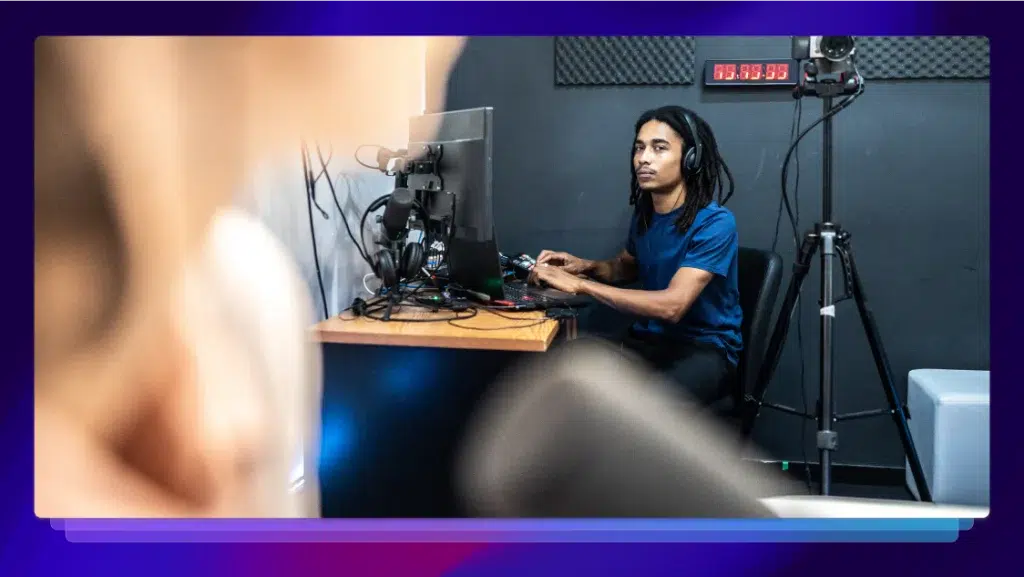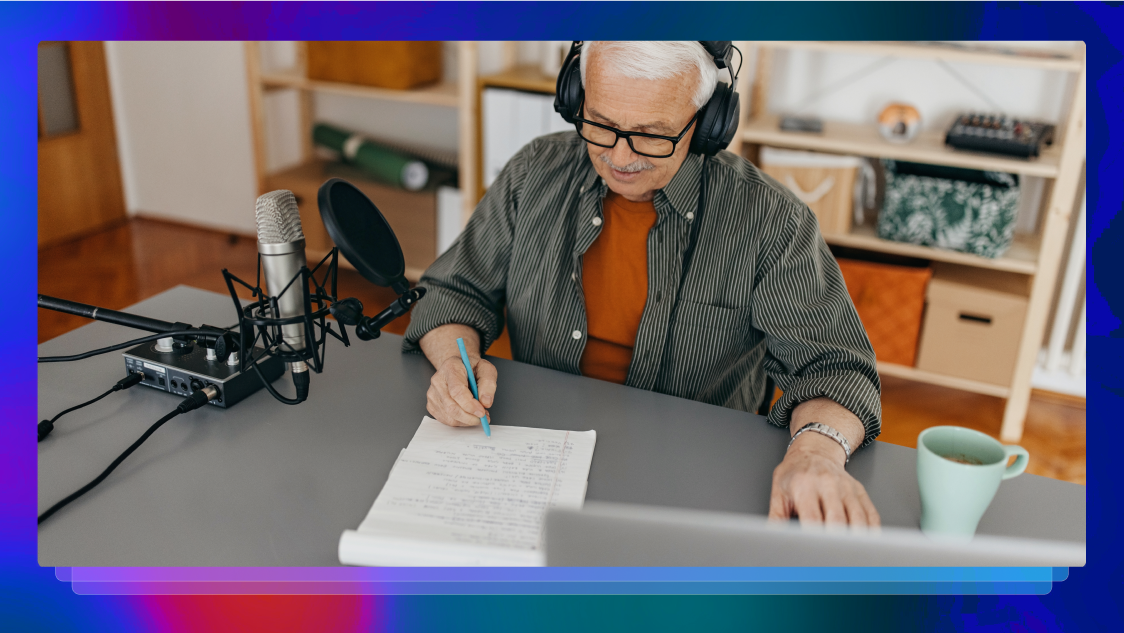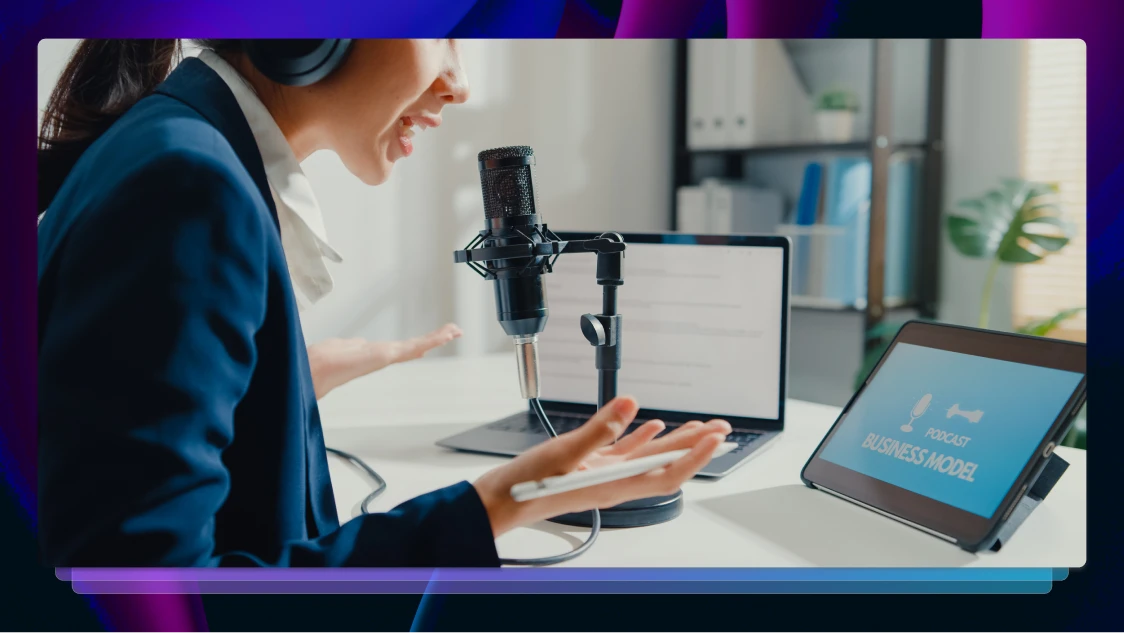How to Get Your Podcast Transcription in Just a Few Steps
Podcast transcription is a vital step to growing your podcast’s audience. Here’s how to get a podcast transcription in four steps.

You know you’re making a great podcast. Your theme is engaging, your guests are interesting, and your editing and production are cutting-edge. And yet, you haven’t quite found your podcast audience. Or, more accurately, your audience hasn’t found you.
While finding an audience for your podcast is a multi-faceted endeavor that takes time (we should know — we have our own podcast The Rough Draft), you can take a big step in the right direction by adding podcast transcription to every episode.
The bottom line is that podcasts with transcripts are more accommodating to listeners and more easily scannable by search engines. Luckily, it’s easy to transcribe podcast audio. With a professional audio-to-transcript service, you can have SEO-friendly and content-rich copy that increases access to your podcast and boosts web traffic in no time at all. Here are the steps to getting your podcast transcribed in a snap.
1. Upload Your Podcast Audio or Video
There are multiple ways to upload your podcast to your podcast transcription service. At Rev, you can upload an actual file (if, say, your podcast audio or video file is downloaded on your computer) to our transcription checkout page.
Though MP3 and MP4 files are the best format for audio transcription, we accept all major audio and video file formats, including MP3, MP4, WMV, AIF, M4A, MOV, AVI, VOB, AMR, WMA, OGG, and AAC.
But if you’ve already posted a polished version of your podcast online, you can simply paste your URL (as long as it’s public) into the box on the same checkout page and we’ll turn your posted podcast to text. It’s that easy to get started!
2. Choose Additional Options
After you upload or link your podcast, you can choose from a list of enhanced podcast transcription options that can be incredibly helpful, especially if you’re facing a time crunch.
- You can rush your transcript, which will get you a final transcription five times faster.
- You can add timestamps, which we strongly recommend for any transcription. Timestamps make it much easier to reference and find quotes and information throughout a recording.
- You can get a “verbatim” transcript, which includes all words and sounds as spoken. That means it includes all “uhs,” “ums,” stops and starts, and other non-verbal sounds.
- You can get an “instant first draft” with an AI podcast transcript. We’ll still be hard at work creating a thorough and accurate human-generated transcript, but if you need a quick version, this option is pretty great!
- You can choose to add glossary terms, accent information, and speaker names to your podcast transcript. Once payment for your order has been processed, our system will prompt you to provide resource information for your order.
- You can also choose your transcription language. Rev offers transcription in 38 different languages. That’s a lot of potential audience!
3. Get Your Podcast Transcription
Rev can provide your podcast transcription in as little as five minutes. You’ll be notified in your account and via email when your transcription is ready for download.
When you decide to download your podcast transcript, you can choose a Word, PDF, or TXT file, this can be done from your account’s workspace and the Rev transcript editor. Speaking of which…
4. Edit Your Transcript, If Needed
If you’re not happy with your final podcast transcript, don’t fret. You can edit as needed.
When your transcript is complete, you will also receive an email with a link to our free online editor where you can view, edit, and download your transcript. The editor can also be accessed by clicking the file name on your Workspace page. Note you must be a subscriber to use the editor.
Using the Rev transcript editor, you can listen along with the audio, make edits, adjust speaker labels, and even take notes. Once you’re done reviewing and editing, you can download your transcript directly from the editor. If that sounds intimidating, you can test the features of our editor. See? Easy peasy!
If editing the full transcript is still too daunting, you can access the Rev Transcript Assistant, which can quickly generate a summary of your transcript and discover actionable insights. Note you must be a subscriber to use the AI assistant.
Once your podcast is fully edited and you’ve downloaded your file, you can then upload your podcast transcript to your preferred podcast host, like Spotify.
Other Ways to Get a Podcast Transcription
While we fully believe that Rev’s podcast transcription service is the quickest and most trustworthy way to turn podcast audio into transcript form, we’re not the only game in town. Here are some other ways you can get your podcast transcribed.
- RSS.com offers free podcast transcription. This is a handy feature since you’ll need an RSS feed in order to distribute your podcast anyway.
- YouTube’s free video transcription service works with podcasts, too.
- Google Recorder instantly transforms audio into text, although there are reports that the speech recognition isn’t as good as other services.
- Podcast transcription software is available, although they vary in quality and cost. The most popular versions are the Riverside.fm podcast transcription tool and SimonSays.
Why Rev is the Best Choice for Podcast Transcription
Rev is the best choice for podcast transcription because we’re quick, accurate, and easy to use. But we also offer so much more than the competition.
Our transcript editor is the most comprehensive in the game. Our “instant” option keeps you working while we prepare a final draft. Our AI podcast tools add loads of functionality to your transcript. And our vast network of transcriptionists means that there’s never a backup in service, so your podcast transcription will always be delivered when you need it.
Below are more reasons to use Rev as your go-to podcast transcription service:
Accuracy Guaranteed
Rev offers human and AI Transcription services to help your podcast reach listeners all over the world. Our human Revvers offer podcast transcription that is up to 99% accurate, while our advanced AI podcast transcript service can create podcast transcriptions with up to 90% accuracy almost instantly.
Largest Network of Transcriptionists in the World
Rev’s network of transcriptionists is highly experienced, trustworthy, and always available to create accurate podcast transcriptions.
Excellent Customer Support
Need help using Rev’s tools or platform, finding new ways to leverage our transcription services, or simply looking for answers regarding your account or subscription? Check out our Help Center or get in touch with customer support. We’ll get you the answers you need nearly as quickly as we’ll get you a transcript.
Word-Class Podcast Transcription Editing Tools
By using Rev as your podcast transcription service, you gain automatic access to our powerful Transcript Editor tool. Edit on your own or enlist our AI Transcript Assistant to make suggestions and offer insights about how to get the most from your transcription.
Benefits of Podcast Transcription
The primary benefit of podcast transcription is that it lets more people find and use your podcast. Your podcast transcript adds vital content to your website that makes the search engine crawlers happy, and it allows people who can’t use audio to enjoy and understand your work.
Maybe they’re deaf or hard of hearing. Maybe they simply forgot their headphones at home and don’t want to bother everyone else at the airport (and we thank them for that). Regardless, offering a text form of your audio vastly increases your potential pool of users. Other benefits include:
- SEO ranking. Audio-only simply doesn’t register for SEO purposes. When you transcribe your podcast, you’re adding robust content that Google’s crawlers LOVE, which will lift your search rankings. Some podcast services, like Apple, let listeners search transcripts to find the podcasts they’re looking for. That’s a handy tool that can get your podcast in front of more people — but your show will only show up if it’s transcribed.
- Accessibility. If you don’t transcribe your podcast, you’re shutting out anyone who can’t use audio. This is placing a cap on your potential audience and it might even get you into legal trouble.
- Broader appeal. Some people just prefer to read, whether they are able to use audio or not. No matter what your podcast is about, there will always be a select group within your potential audience who prefers to read rather than listen. Podcast transcription offers them a way to still access your content.
How Much Does It Cost To Transcribe a Podcast?
Podcast transcription can be as low as 25 cents per minute for AI transcription or $1.99 per minute for human transcription.
If you need bulk transcription, a Rev Business Plan might be for you. Built for customers who need 20 or more hours of transcripts, captions, or subtitles a month, Rev for Business streamlines your biggest projects and saves your budget with bulk pricing.
Make Sure Your Podcast Gets Seen And Heard With Rev
You’ve put so much work into your podcast. It would be a shame to waste it by limiting your audience, wouldn’t it? Podcast transcription is a great way to get your podcast out to more people and provide keyword-rich content for your website. If you’re ready to expand your audience, well, we’re here to help you do podcast transcription the right way.















